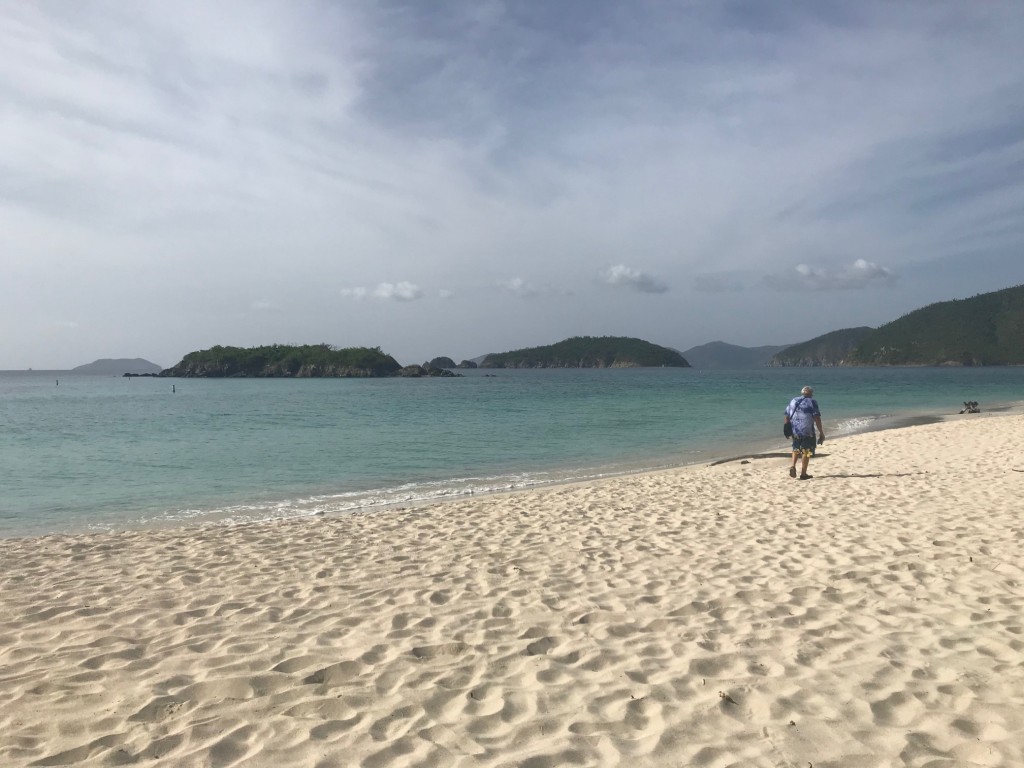Hurricane Irma–One Year Later

Everybody here on St. John is talking about the weather. There’s something out there. It’s not Florence, or Gordon. It doesn’t even have a name yet, isn’t technically a storm, but it’s out there, coming off the coast of Africa, first a yellow X on the National Hurricane Center map, then an orange one, now red, each color change indicating its chances of becoming something bigger just got a little better.
It doesn’t have to be a big storm to do damage. Late last week a tropical wave passed through, bringing wind gusts up to 60 mph—strong enough to rip up your new screen door, more than enough to trigger the PTSD. Some eight inches of rain fell in one day, causing flooding and rockslides. If your home was one of the hundreds without an adequate roof, everything was wet. Again.
And then the sun comes out, as if to mock any suggestion that everything isn’t back to being perfect in paradise. The water is blue, and warm, and full of fish. The flamboyant trees are bursting red blooms. Yesterday I drove out to the ruins at the Annaberg sugar plantation and three great egrets took flight in front of my Jeep, their pure white feathers a surreal beauty against the starkness of barren mangroves. The sky the last few nights has been cloudless, moonless, and dripping with stars, with a parade of planets bisecting the Milky Way.
One year ago today, Hurricane Irma attacked St. John and the surrounding islands with 220+ mph winds. It didn’t even make the news in the States, where all the attention was on Florida. Less than two weeks later, Hurricane Maria, a second Category 5 storm, tore at what was left. When it was all over, the island was decimated, two boaters were dead, and the lives of 5,000 survivors were in chaos.
People ask how it is down here now and it’s impossible to answer succinctly. Every day things are better, and every day there is so much more to do. For some people life is getting back to normal, if a little rough around the edges. For others, life is still very hard. School was supposed to start this week, and it did, for students at Gifft Hill, the private school that accepted children tuition-free after the hurricanes and offered generous financial aid this year. But the public school opening has been delayed two weeks, at least, and when students at JESS elementary return, they’ll be in temporary “modular classrooms”—windowless trailers crammed side by side on the ball field where the kids used to play
The Westin, one of the island’s two big hotels and a major employer, is on track to reopen in January, but Caneel Bay, the ritziest place on the island, looks much as it did the day Irma hit. Ditto for the Cinnamon Bay campground. Both resorts are privately run, on National Park land leased in apparently complicated deals. Both sit untouched, desolate as the day after Irma blew through, as disputes about insurance and leases and who should be responsible drag on. SHAME someone scrawled on a piece of wood propped up at the entrance to Cinnamon Bay.
Looking at photos and video of the aftermath, it’s hard to believe it’s the same place. So much has changed for the better. But a lot of what’s changed can be measured by what you don’t see. There is an acute absence of things. Palm trees. The particular curve of a favorite beach. People.
With homes and businesses destroyed, fewer jobs and places to live, some people are simply no longer here. Families are separated while children go to school in the States, or one parent works here, the other there. Familiar faces from restaurants and shops have disappeared. In one week, two friends of mine, long-time islanders, listed their homes for sale, one saying she can no longer afford to live here, the other saying he can no longer stomach it. Hurricane Beryl was the last straw. Don’t remember it? For most people there was no reason to. There wasn’t much threat when it passed by St. John in July, but for someone suffering from PTSD, hunkering down in his home on a windy ridge, listening to the howls and rattles, it was excruciating. That’s just one story. One of 5,000 here, one of thousands more in Puerto Rico, the British Virgin Islands, Houston.
People also ask how they can help, and that’s an easier question to answer. You can visit. Tourism drives the economy and the island needs the business. The beaches are gorgeous and the views spectacular; there are plenty of places to eat, drink, and sleep; and the people have an irrepressible spirit. You can also donate. The St. John Community Foundation, meeting the needs of underserved islanders for 30 years, and the Coral Bay Community Council, fighting to preserve the environmentally sensitive harbor area adjacent to the National Park, are two good places to start.
The island is fragile. The people are fragile. Today, September 6, survivors will mark the anniversary in different ways. Some are planning quiet dinners with the people with whom they rode out the storm, some in the homes where they took shelter. There’s a pig roast at Aqua Bistro in Coral Bay, and a potluck at Pickles. Many people have told me they aren’t sure what they’re doing, how—or if—they want to mark the day. They’ll wait and see how they feel.
The St. John Community Foundation tonight hosts a party to release a new CD called “Love City Rise Up!”—a “We Are the World”-style recording featuring singers and musicians from the island. The gathering at High Tide in Cruz Bay will be a short pause in their work, a celebration of reaching this milestone.
Then tomorrow, the rebuilding resumes. Along with the checks of the weather. September is the worst month for hurricanes, and we’re still only in the first week.
